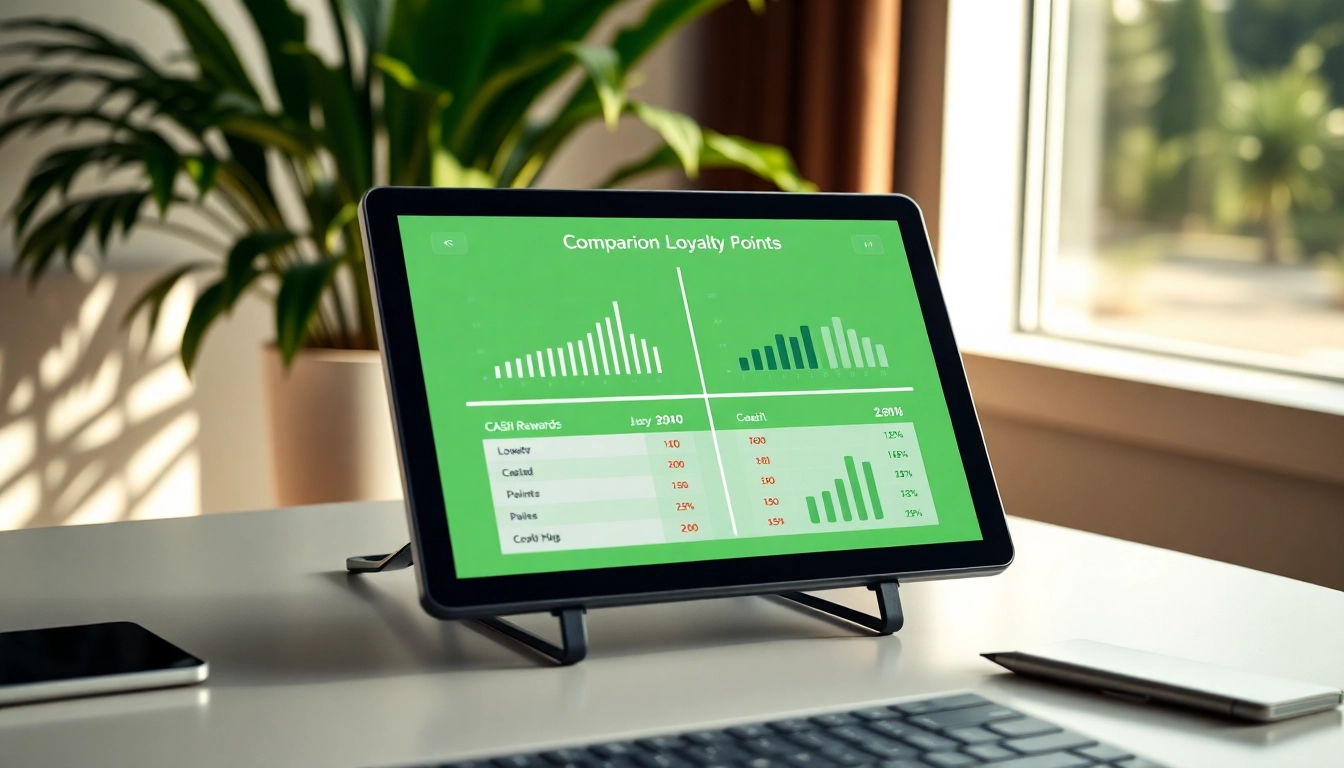Understanding Points Comparison
The Basics of Points Systems
In today’s economy, earning rewards through points systems has become a popular way for consumers to receive benefits from their purchases. Points systems can be found in various sectors, such as travel, retail, and hospitality, where users earn points for every dollar spent. These points can be redeemed in different ways, including discounts, free products, or upgrades. However, understanding how these points work is crucial for maximizing their value. For individuals looking to optimize their rewards, points comparison is an essential tool.
Points systems generally work on a simple principle: the more you spend, the more points you earn. However, the conversion rate of points to actual value can vary significantly between programs. Hence, comprehensively understanding your program’s structure, redeeming flexibility, and earning potential can greatly enhance your reward-seeking endeavors.
Importance of Points Comparison
The value of a rewards program is not solely based on the number of points earned; it’s also about how those points can be redeemed. This is where points comparison becomes vital. By assessing different programs and understanding their redeeming values, users can identify where they can gain the most benefits.
Moreover, points comparison allows consumers to make informed decisions when choosing credit cards or loyalty programs, ensuring they aren’t losing out on potential rewards. Choosing a card with higher points per dollar spent can dramatically increase the total rewards received over time.
Types of Points Systems
Points systems can generally be categorized into three types:
- General Rewards Points: These points are typically issued by credit cards and can be redeemed in various ways, giving users flexibility.
- Airline Miles: Specific to airline loyalty programs, these points can often be used for flights, upgrades, and other travel-related expenses.
- Hotel Points: Similar to airline miles, these points are issued by hotel chains and can be redeemed for free nights, room upgrades, or other hotel services.
Understanding these different types of points helps consumers identify which system aligns best with their spending habits and travel preferences.
How to Compare Points Effectively
Key Metrics for Points Comparison
When comparing points, it’s essential to look at several key metrics. These include:
- Redemption Value: This metric indicates how much a point is worth when redeemed for flights, hotel nights, or cash back. Understanding this value can significantly affect how you rate a program.
- Earn Rates: Look into how many points you earn per dollar spent. Some programs offer more points for specific categories, like dining or travel.
- Redemption Flexibility: Programs that allow for flexible redemption options can enhance the overall value of points earned. You want to choose a program that enables you to use your points in various ways.
- Expiration Policies: Some points expire if not used within a certain time frame. Knowing the expiration policies helps in planning your point usage.
By analyzing these metrics, you can create a comprehensive view of which rewards program best meets your lifestyle and goals.
Tools for Points Comparison
Several tools and platforms are available to assist consumers in comparing points efficiently. These tools can help users evaluate different programs based on their unique needs. Some popular options include:
- Points Valuation Calculators: Many websites offer calculators that help you determine the cash value of points from various programs. This can greatly simplify your decision-making process.
- Reward Aggregators: Platforms that gather information from multiple loyalty programs and present it in an easy-to-compare format can be invaluable.
- Mobile Apps: Some travel and finance apps allow real-time tracking of points and their potential value, enabling users to make on-the-go comparisons.
Using these tools can save time and streamline your reward comparison process, leading to better-informed choices.
Common Pitfalls in Points Comparison
While comparing points, consumers often fall into common traps that may lead to suboptimal choices. These pitfalls include:
- Focusing Solely on Earn Rates: While high earn rates are attractive, they are useless if the redemption value is low.
- Ignoring Expiration Policies: Failing to consider the expiry of points can lead to the loss of valuable rewards.
- Underestimating Fees: High fees attached to redeeming points can diminish their actual value, so it’s important to factor those in as well.
Avoiding these pitfalls will create a more effective strategy for maximizing the value of points earned.
Maximizing Value through Points Comparison
Strategies for Enhanced Points Comparison
To enhance points comparison, consider these strategies:
- Set Your Goals: Define what you want to achieve with your points. Is it free travel, hotel stays, or cash rewards? Knowing your goals will help narrow down your options.
- Review Multiple Programs Regularly: Keep an eye on different points programs and their offers. Regular reviews can help you capitalize on beneficial promotions and updates.
- Leverage Point Transfers: Some programs allow you to transfer points to airline partners. This can enhance your point’s value if managed strategically.
By implementing these strategies, you can ensure a more thorough and efficient comparison process that aligns well with your personal objectives.
Analyzing Costs vs. Benefits
Understanding the costs associated with earning and redeeming points is crucial for effective points comparison. Start by calculating how much you need to spend to earn enough points for a reward you desire. Consider:
- Membership Fees: Some credit cards and loyalty programs may charge annual fees.
- Redemption Costs: Check if there are any taxes or fees upon point redemption, as these can affect your calculations.
- Opportunity Costs: Consider other possible uses for the money spent. Is a reward worth it compared to other financial opportunities?
Analyzing these elements holistically allows for a deeper understanding of whether a points program is truly beneficial.
Case Studies on Points Comparison
Examining real-life case studies provides valuable insights into points comparison. For instance:
- Traveler A: Maximized travel rewards by strategically choosing a credit card offering higher earn rates on airfare and hotel stays. By comparing programs, they ended up spending less on travel due to boosted point values through airline partnerships.
- Shopper B: Chose a general rewards card that provided flexibility in redeeming points for shopping, ensuring they always got good value based on their regular spending habits.
These examples illustrate how proper points comparison can lead to tangible financial benefits.
Points Comparison Across Different Programs
Airline Mileage vs. Hotel Points Comparison
When comparing airline mileage with hotel points, various factors come into play. Airline miles often provide more significant value per point when redeemed for flight upgrades or international travel. Conversely, hotel points can be more flexible, allowing for varied experiences beyond just free nights.
Understanding the specific redemption opportunities available in each program can help you assess where your effort yields more value. Consider what aligns best with your travel habits and compare the metrics effectively to make a better decision.
Cashback Rewards Versus Points Comparison
Cashback rewards programs often seem simpler compared to points programs focused on travel. By earning a percentage of your spending back in cash, you avoid the complexities of points redemption. However, comparing points to cashback can yield significant differences in value, particularly when deployed strategically.
For instance, if earning points translates into higher overall rewards on travel experiences than what you’d receive through cashback, it might be prudent to favor point-based systems, particularly for avid travelers.
Credit Card Offers: Points Comparison Insights
Different credit cards have varied reward structures that require thorough comparison. Many cards offer introductory bonuses that can significantly boost initial point accumulation. Additionally, it is crucial to analyze ongoing point earn rates, categories that earn more points, and any fees attached to the card.
Evaluating these elements holistically allows consumers to select a card that suits both short-term and long-term financial strategies. Having the right credit card can enhance the overall effectiveness of a points comparison approach.
Future Trends in Points Comparison
Technological Advances Impacting Points Comparison
The landscape of points comparison is evolving thanks to advancements in technology. AI and machine learning algorithms are now being utilized within points calculators to provide personalized recommendations and value estimates based on spending habits and preferences. Additionally, mobile applications that track points across various platforms are becoming more common, making it easier for users to keep tabs on potential rewards and optimal redemption strategies.
These technological advances are set to transform how consumers approach points comparison, driving more informed decisions as technology simplifies the complexity surrounding loyalty programs.
Shifting User Preferences in Points Comparison
As user preferences continue to shift, there is a noticeable trend towards programs that offer more seamless, mobile-friendly experiences. Simplicity and transparency have become paramount, with consumers favoring programs that clearly communicate earning and redemption values.
Moreover, there is a growing interest in experiences over material rewards, pushing loyalty programs to evolve with more diverse reward offerings that align with changing customer expectations.
Predicting the Future of Points Comparison
The future of points comparison will likely be shaped by greater consolidation within the industry, leading to fewer, but more robust, programs. This consolidation may drive enhancements in user experience and provide customers with better rewards for their loyalty.
Additionally, we can expect a stronger emphasis on environmental sustainability and ethical practices within rewards programs, as consumers become increasingly aware of their impact and seek brands that align with their values. This shift will create new avenues for points comparison, as users emphasize overall brand responsibility alongside traditional benefits.



